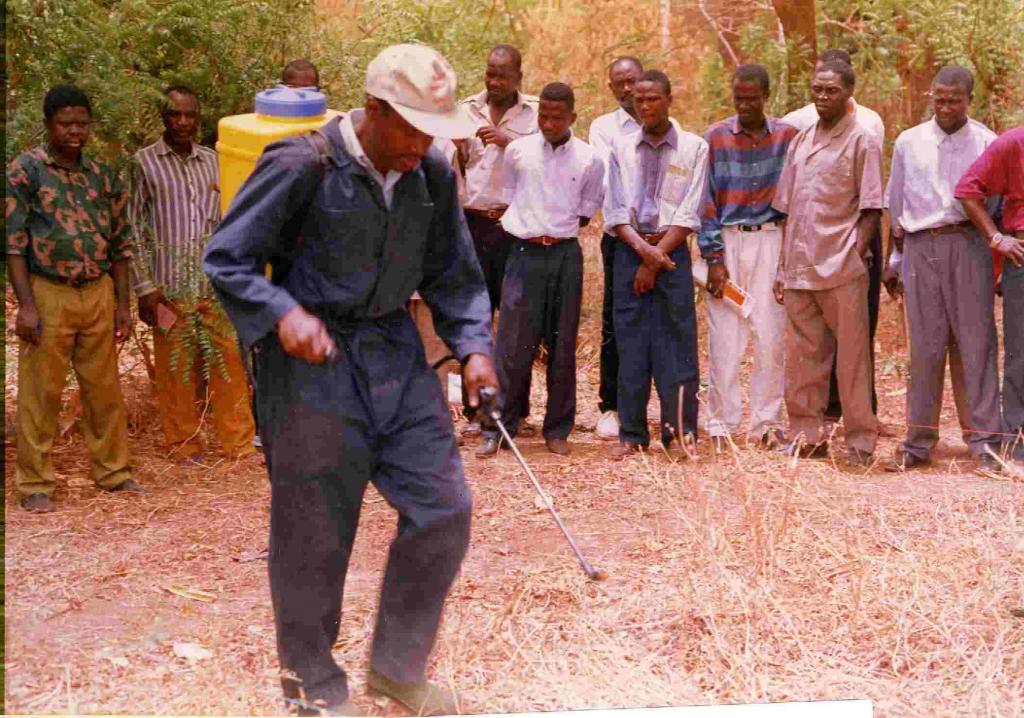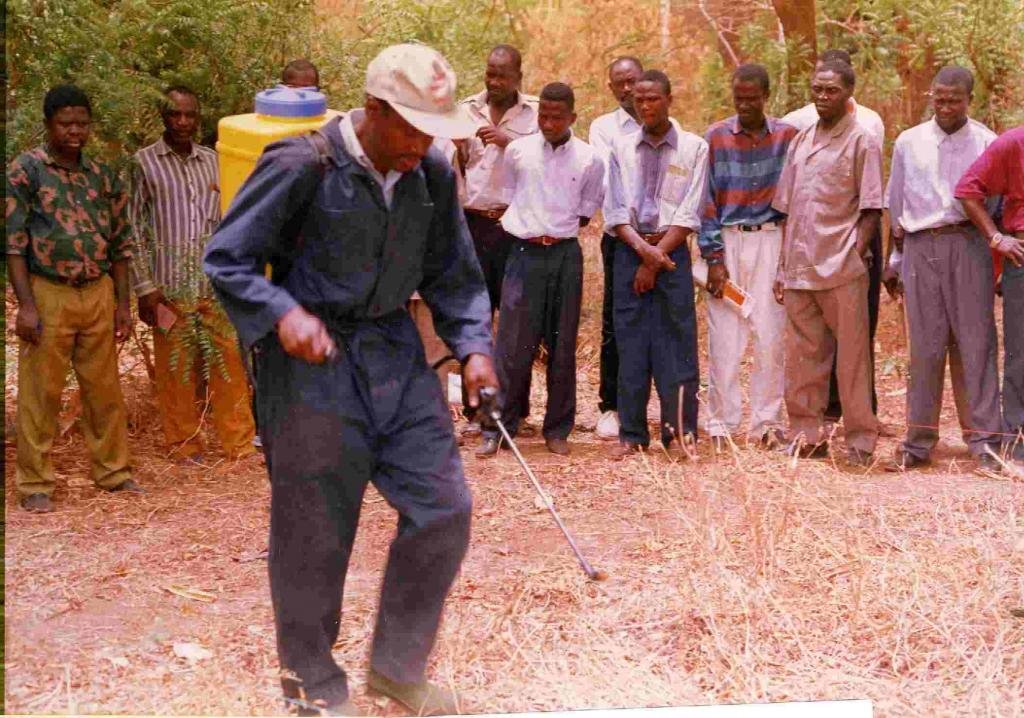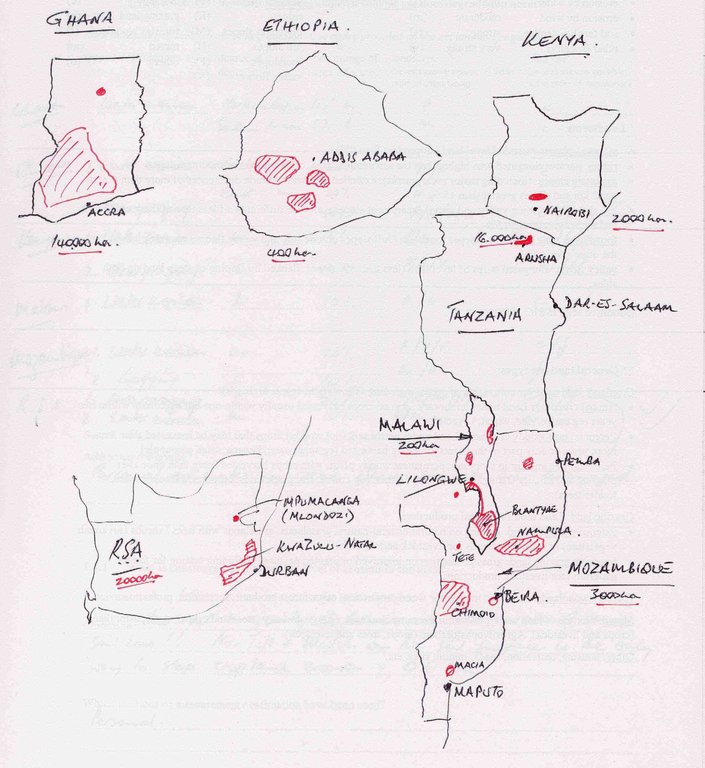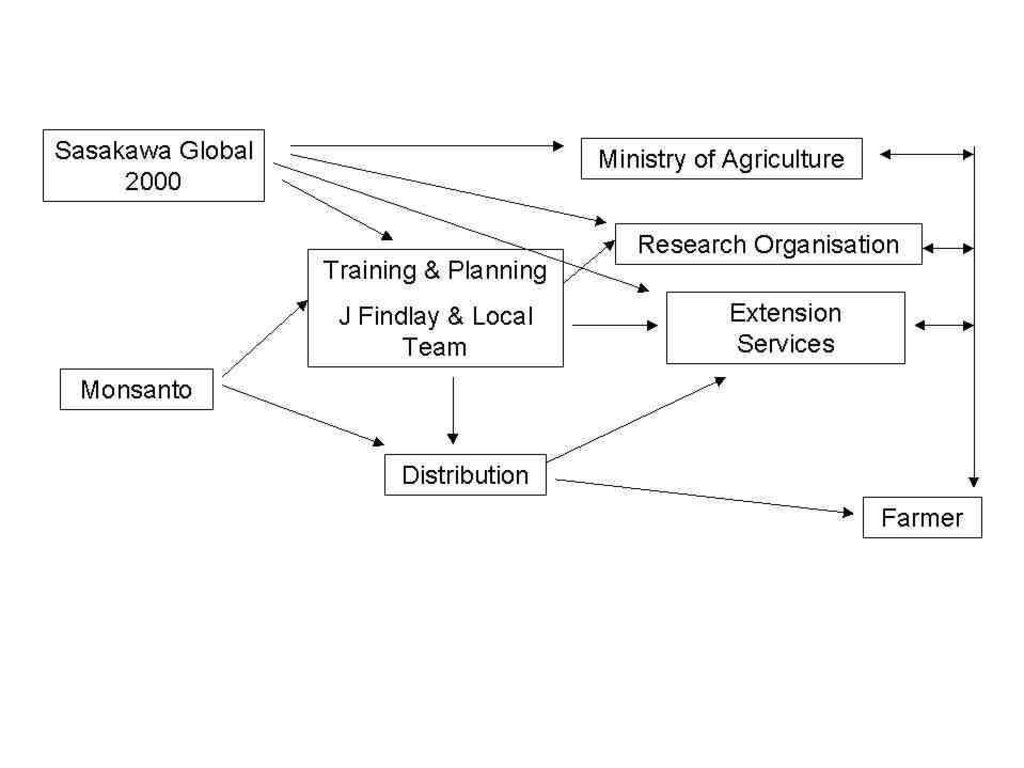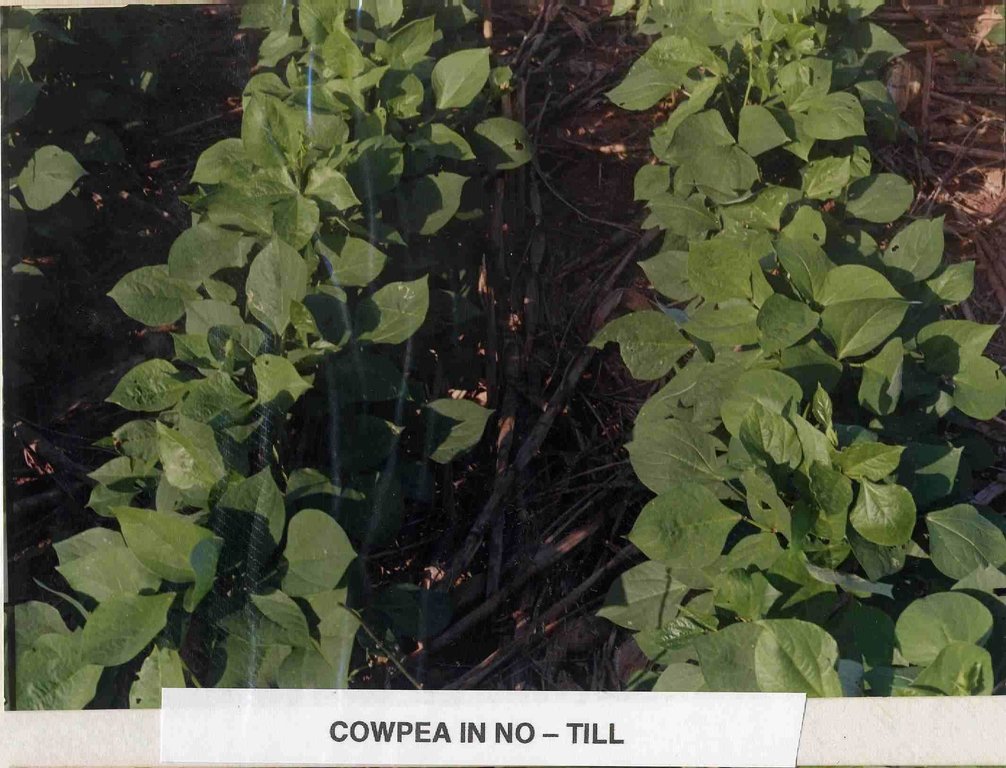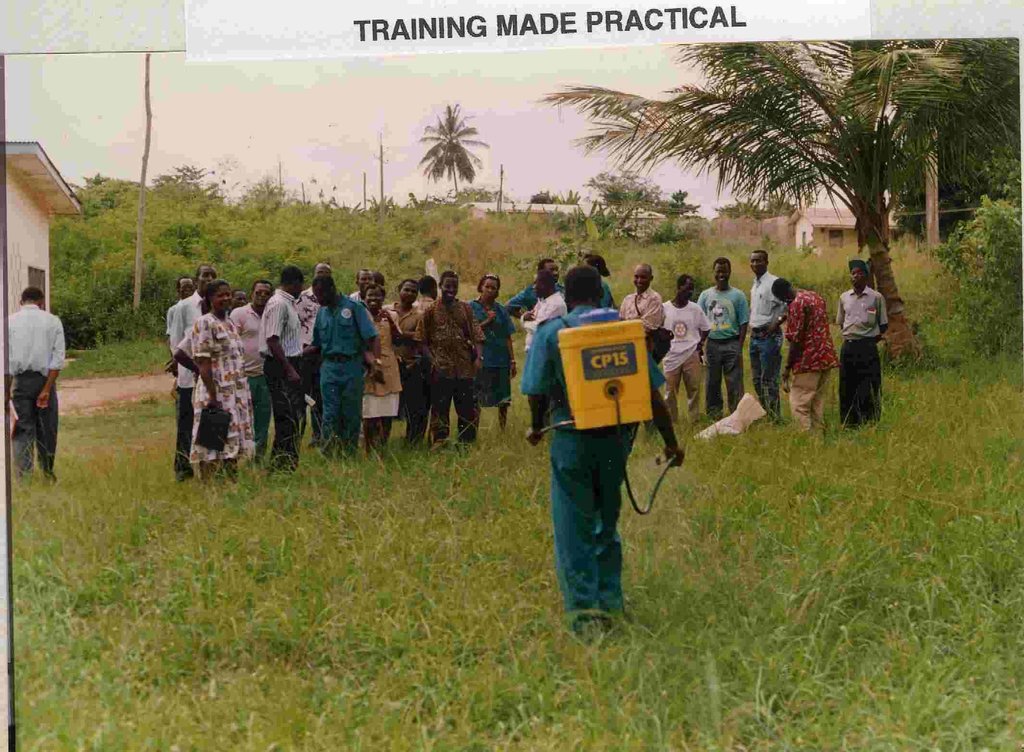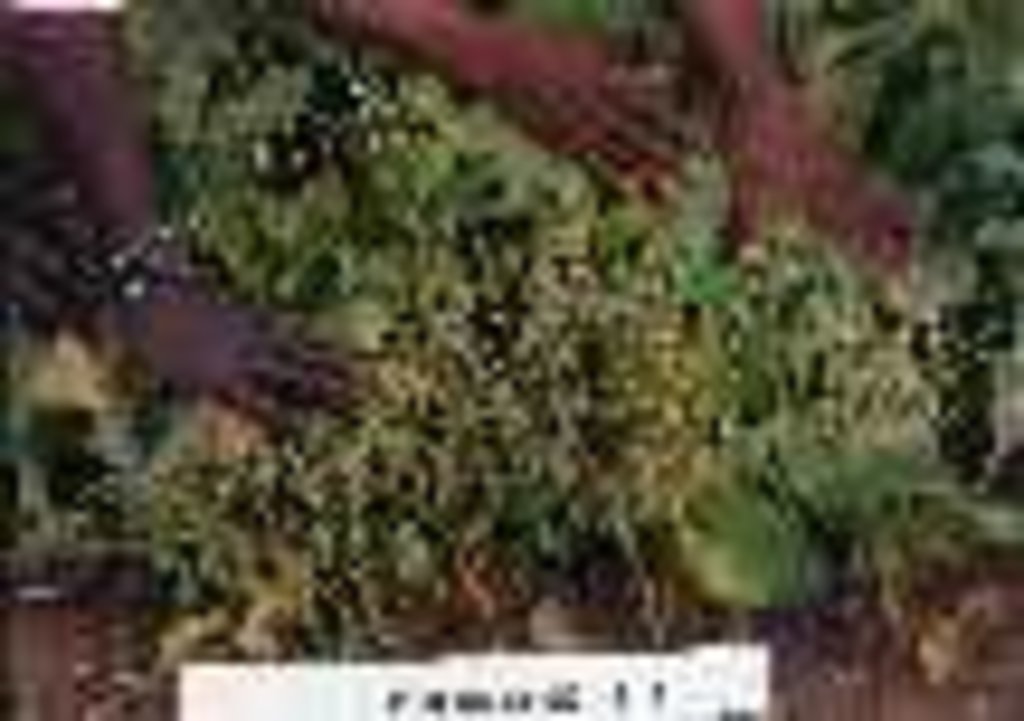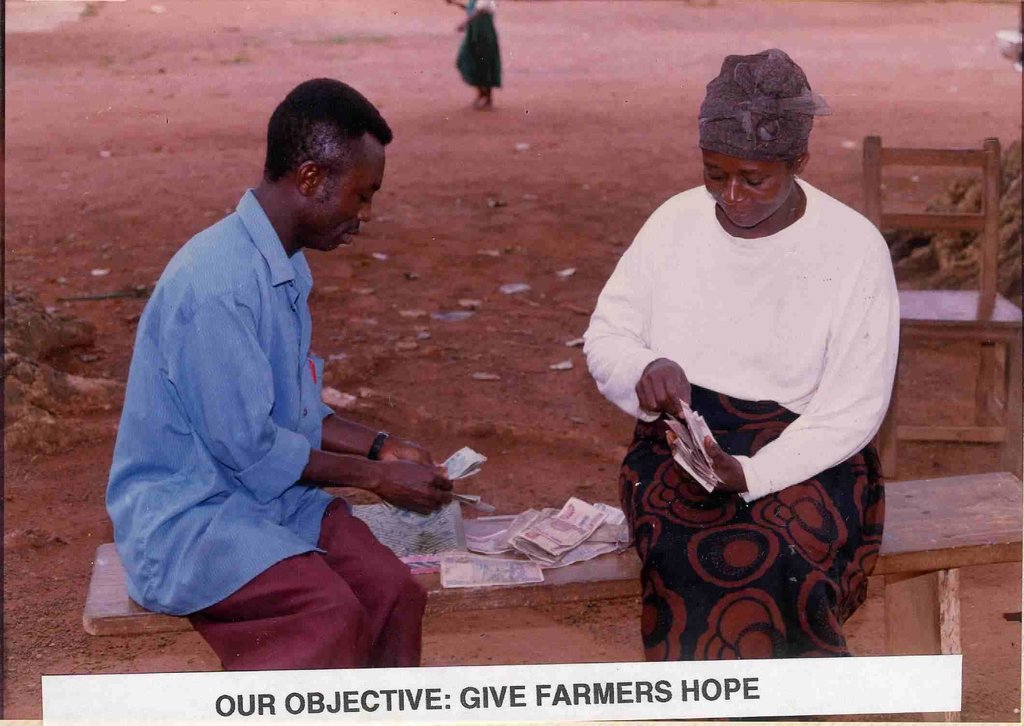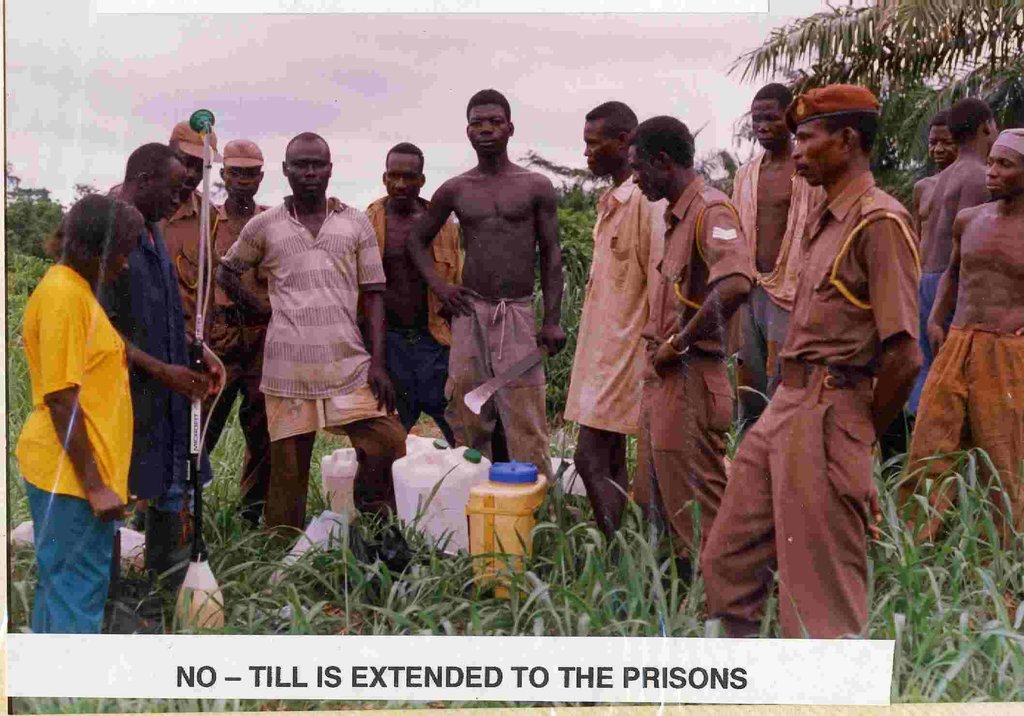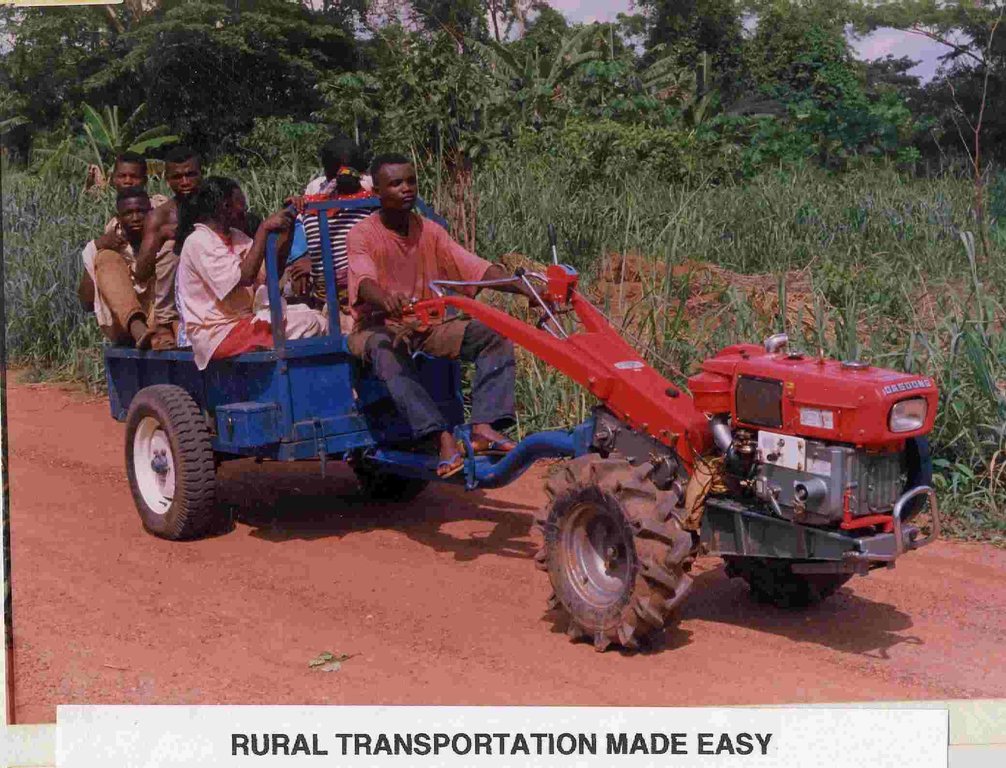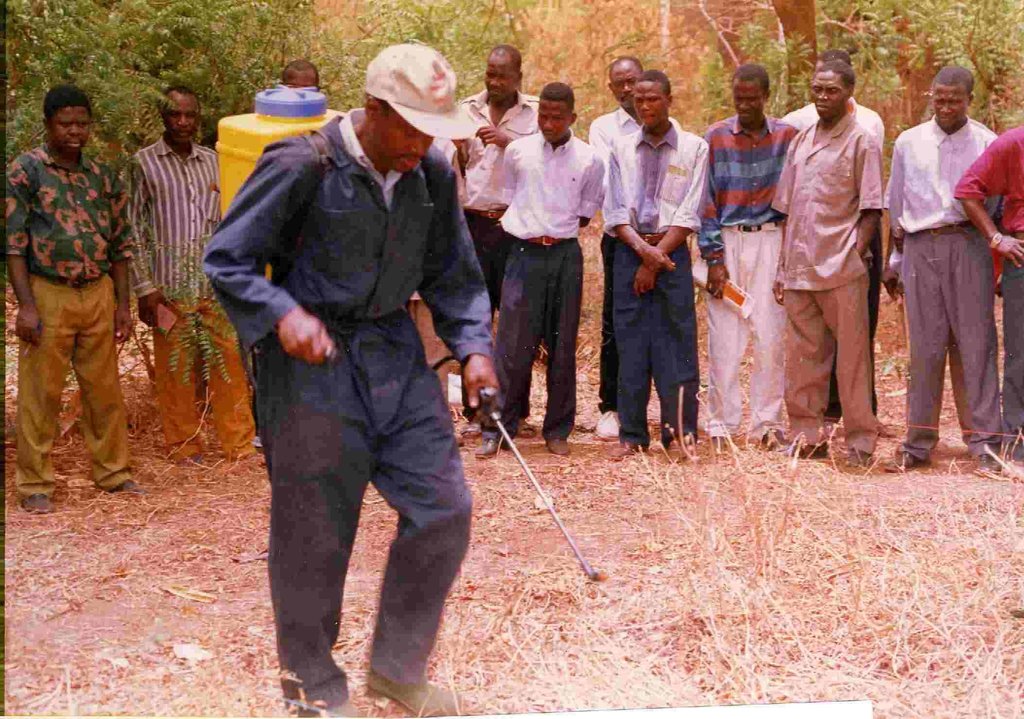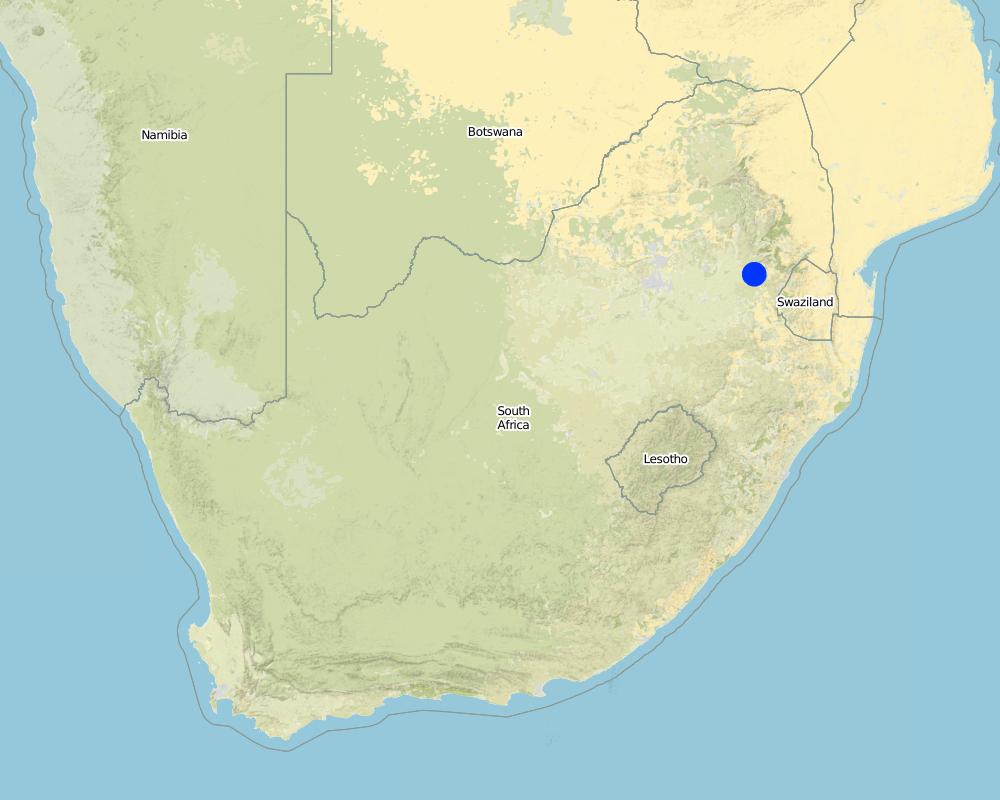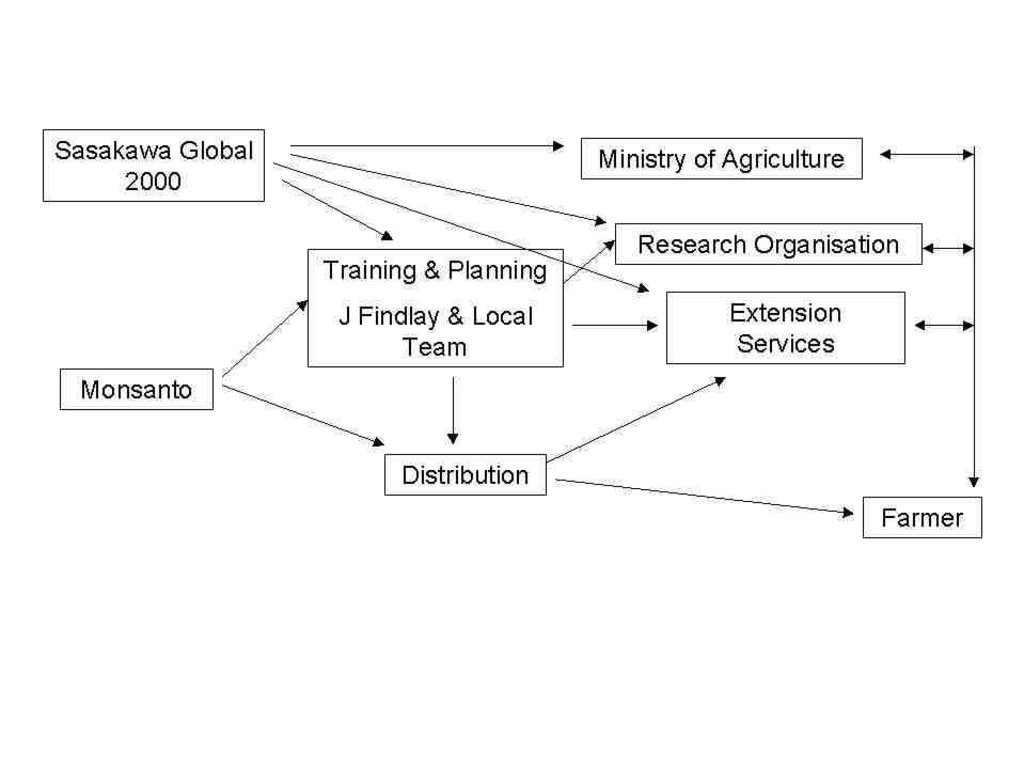All participants, with the emphasis of getting know-how to the farmer [ប្រទេសអាហ្រ្វិកខាងត្បូង]
- ការបង្កើត៖
- បច្ចុប្បន្នភាព
- អ្នកចងក្រង៖ Unknown User
- អ្នកកែសម្រួល៖ –
- អ្នកត្រួតពិនិត្យ Fabian Ottiger
approaches_2416 - ប្រទេសអាហ្រ្វិកខាងត្បូង
ពិនិត្យមើលគ្រប់ផ្នែក
ពង្រីកមើលទាំងអស់ បង្រួមទាំងអស់1. ព័ត៌មានទូទៅ
1.2 ព័ត៌មានលម្អិតពីបុគ្គលសំខាន់ៗ និងស្ថាប័នដែលចូលរួមក្នុងការវាយតម្លៃ និងចងក្រងឯកសារនៃវិធីសាស្ត្រផ្សព្វផ្សាយ
បុគ្គលសំខាន់ម្នាក់ (ច្រើននាក់)
អ្នកជំនាញឯកទេស SLM:
Findlay James B R
ប្រទេសអាហ្រ្វិកខាងត្បូង
1.3 លក្ខខណ្ឌទាក់ទងទៅនឹងការប្រើប្រាស់ទិន្នន័យដែលបានចងក្រងតាមរយៈវ៉ូខេត
អ្នកចងក្រង និង(បុគ្គលសំខាន់ៗ)យល់ព្រមទទួលយកនូវលក្ខខណ្ឌនានាទាក់ទងទៅនឹងការប្រើប្រាស់ទិន្នន័យដែលបានចងក្រងតាមរយៈ វ៉ូខេត:
បាទ/ចា៎
2. ការពណ៌នាអំពីវិធីសាស្ត្រផ្សព្វផ្សាយ SLM
2.1 ពណ៌នាសង្ខេបខ្លីពីវិធីសាស្ត្រផ្សព្វផ្សាយ
Introduction of No-Till crop production systems to rural small scale farmers.
2.2 ពណ៌នាលម្អិតពិវិធីសាស្ត្រផ្សព្វផ្សាយ
ពណ៌នាលម្អិតពិវិធីសាស្ត្រផ្សព្វផ្សាយ:
Aims / objectives: Convert small-scale farmers from conventional ploughing to minimum tillage to no-till crop production. Introduce/upgrade technology by using certified seed, fertilisers, herbicides and pesticides. Associated cost increase results in a time saving which allows for additional production. Increased yields result in wealth creation. Develop marketing options for farmers e.g. a maize farmer can sell green maize (boiled or roasted) for human consumption, maize grain, maize meal, poultry feed or poultry, small or large livestock feed or the carcass (feedlots). Change perception that farmers produce food for own consumption only. They must produce a surplus for sale to generate an income which is wealth creation in the rural areas. Rich farmers = Wealthy Nation Poor farmers = Poor Nation Government policies must support rural farmers and ensure a good price for agricultural produce. Upgrade the knowledge/skills level of extension officers (E.O.s) - gain farmers respect for E.O.s. E.O.s must be measured on farmer performance. Improve the link and information flow from research organisations to E.O.s (and then to the farmer). Research organisations are encouraged to initiate no-till projects to support farmers and E.O.s, e.g. herbicides for weed problems; fertiliser deficiencies and recommendations; crop options.
2.3 រូបភាពនៃវិធីសាស្ត្រផ្សព្វផ្សាយ
2.5 ប្រទេស/តំបន់/ទីតាំងកន្លែង ដែលវិធីសាស្ត្រផ្សព្វផ្សាយត្រូវបានអនុវត្តន៍
ប្រទេស:
ប្រទេសអាហ្រ្វិកខាងត្បូង
តំបន់/រដ្ឋ/ខេត្ត:
Mpumalanga
Map
×2.6 កាលបរិច្ឆេទនៃការចាប់ផ្តើម និងបញ្ចប់នៃវិធីសាស្រ្តផ្សព្វផ្សាយនេះ
សូមបញ្ជាក់ឆ្នាំដែលបានបង្កើតឡើង:
1998
2.7 ប្រភេទនៃវិធីសាស្ត្រផ្សព្វផ្សាយ
- ផ្អែកលើគម្រោង/កម្មវិធី
2.8 គោលបំណង/ទិសដៅសំខាន់នៃវិធីសាស្ត្រផ្សព្វផ្សាយ
The Approach focused mainly on SLM with other activities (Training. Field implementation. Technology implementation review. Input supply system. Finance support. Processing and marketing.)
Introduce no-till crop production systems. Make farming profitable. Create markers - input and output. Develop local knowledge / expertise. Reduce / stop soil erosion.
The SLM Approach addressed the following problems: Lack of political support (e.g. Tanzania). Policy/ Know-how's. Mechanisation is expensive - No-Till cheap - demonstrate. Soil and Water conservation. Crop surplus production - sale/process - financial benefit.
2.9 លក្ខខណ្ឌអនុញ្ញាត ឬរារាំងការអនុវត្តន៍បច្ចេកទេសដែលស្ថិតនៅក្រោមវិធីសាស្រ្តផ្សព្វផ្សាយ
សង្គម/វប្បធម៌/ និងតម្លៃនៃសាសនា
- រារាំង
Overgrazing - too many cattle/too little food Communal land - no responsibility
Treatment through the SLM Approach: Plant pastures - fewer cattle (!!!!)
ភាពអាចរកបាននៃធនធានហិរញ្ញវត្ថុ និងសេវាកម្ម
- រារាំង
Banks do not educate 'poor poverty stricken' farmers in to financial management.
Treatment through the SLM Approach: Banks - educate farmers / take a risk!
បរិបទនៃស្ថាប័ន
- រារាំង
Authorisation attitude by researchers
Treatment through the SLM Approach: Let farmers decide on the advantages of a system
ក្របខណ្ឌច្បាប់ (សិទ្ធិកាន់កាប់ដីធ្លី កម្មសិទ្ធីប្រើប្រាស់ដីនិងទឹក)
- អំណោយផល
The existing land ownership, land use rights / water rights helped a little the approach implementation: hinder: moderate. Communal lands or insecurity of tenure does not encourage investment (money and time). After harvest - communal grazing!
- រារាំង
No legislation permitting genetically modified crops
Treatment through the SLM Approach: Introduce Demo legislation permitting modern agriculture
ផ្សេងៗ
- រារាំង
Tribal chiefs do not allow individual land ownership (freehold) = power
Treatment through the SLM Approach: Government must encourage private land ownership.
3. ការចូលរួម និងតួនាទីរបស់ភាគីពាក់ព័ន្ធ
3.1 អ្នកពាក់ព័ន្ធដែលបានចូលរួមក្នុងវិធីសាស្ត្រផ្សព្វផ្សាយ និងតួនាទីរបស់ពួកគេ
- អ្នកប្រើប្រាស់ដីក្នុងតំបន់/សហគមន៍
Farmer organisations (small limited)
Working land users were work equally divided between men and women (The technology was introduced to). Women probably appreciate the labour and time saving more than men. Socialy disadvantaged involved if they have knowledge on the details of inputs e.g. insect pest and control measures that work.
- អ្នកឯកទេសគ្រប់គ្រងដីប្រកបដោយចីរភាព/ទីប្រឹក្សាបច្ចេកទេសកសិកម្ម
- វិស័យឯកជន
Monsanto - Agriculture input suppliers
- រដ្ឋាភិបាលថ្នាក់ជាតិ (អ្នករៀបចំផែនការ អ្នកសម្រេចចិត្ត)
Ministry of Agriculture - Extension services
- អង្គការអន្តរជាតិ
SG 2000
ប្រសិនមានភាគីពាក់ព័ន្ធច្រើនចូលរួមសូមចង្អុលបង្ហាញភ្នាក់ងារដែលនាំមុខគេ:
Seskwane Global 2000 - organisation, government support. Monsanto - technology, training, inputs. Local - technology transfer.
3.2 ការចូលរួមរបស់អ្នកប្រើប្រាស់ដីក្នុងតំបន់/ សហគមន៍ក្នុងតំបន់ក្នុងដំណាក់កាលផ្សេងគ្នានៃវិធីសាស្រ្តផ្សព្វផ្សាយ
| ការចូលរួមរបស់អ្នកប្រើប្រាស់ដីក្នុងតំបន់/សហគមន៍ក្នុងតំបន់ | សូមបញ្ជាក់នរណាត្រូវបានចូលរួម ព្រមទាំងពណ៌នាសកម្មភាពទាំងនោះ | |
|---|---|---|
| ការចាប់ផ្តើម/ការលើកទឹកចិត្ត | អសកម្ម | other |
| ការរៀបចំផែនការ | អសកម្ម | public meetings; Training of E.O. and farmers. |
| ការអនុវត្តន៍ | ការគាំទ្រពីខាងក្រៅ | responsibility for major steps; Farmers conduct own demonstration with E.O. support. |
| ការត្រួតពិនិត្យ និងវាយតម្លៃ | អន្តរកម្ម | measurements/observations; Farmer supervised by E.O. E.O. compiles report. |
| Research | អន្តរកម្ម | on-station |
3.3 គំនូសបំព្រួញ (ប្រសិនបើមាន)
3.4 ការសម្រេចចិត្តលើការជ្រើសរើសបច្ចេកទេស SLM
សូមបញ្ជាក់តើអ្នកណាជាអ្នកបានសម្រេចចិត្តក្នុងការជ្រើសរើសបច្ចេកទេសដើម្បីយកមកអនុវត្តន៍:
- អ្នកជំនាញឯកទេស SLM បន្ទាប់ពីបានប្រឹក្សាយោបល់ជាមួយអ្នកប្រើប្រាស់ដី
ចូរពន្យល់:
directive (top-down). Also by extension officers. Directive as-well as consultative. A successful method was developed and adopted for local conditions.
Decisions on the method of implementing the SLM Technology were made by by SLM specialists alone (top-down). directive (top-down). Also by politicians and leaders. Directive as-well as consultative. Many land owners/users have no knowledge of fertilisers, pesticides, seed cultivar choice. Guidance is essential.
4. ជំនួយបច្ចេកទេស ការកសាងសមត្ថភាព និងការគ្រប់គ្រងចំណេះដឹង
4.1 ការកសាងសមត្ថភាព/ បណ្តុះបណ្តាល
តើវគ្គបណ្តុះបណ្តាលបានផ្តល់ឱ្យអ្នកប្រើប្រាស់ដី/អ្នកពាក់ព័ន្ធផ្សេងៗទៀតដែរឬទេ?
បាទ/ចា៎
សូមបញ្ជាក់តើអ្នកណាត្រូវបានបណ្តុះបណ្តាល:
- អ្នកប្រើប្រាស់ដី
- SWC specialists, extensionists/trainers, politicia
ទម្រង់នៃការបណ្តុះបណ្តាល:
- អនុវត្តន៍ជាមួយការងារ
- ពីកសិករទីកសិករ
- ទីតាំងបង្ហាញ
- ការប្រជុំជាសាធារណៈ
- វគ្គបណ្តុះបណ្តាល
ប្រធានបទបណ្តុះបណ្តាល:
Agaronomis system. Herbicides and pesticide use. Processing. Fertilisers. Profitability.
4.2 សេវាផ្តល់ប្រឹក្សាយោបល់
តើអ្នកប្រើប្រាស់ដីបានទទួលនូវសេវាផ្តល់ប្រឹក្សាដែរ ឬទេ?
បាទ/ចា៎
សូមបញ្ជាក់ប្រសិនបើសេវាកម្មប្រឹក្សាយោបល់ត្រូវបានផ្តល់ឱ្យ:
- នៅលើដីរបស់អ្នកប្រើប្រាស់ដី
ពណ៌នា/ពន្យល់:
Name of method used for advisory service: Village demonstration; Key elements: 1 time E.O. with 5 - 8 farmers (1 farmers = failure), Supply inputs for 0.1 ha demonstration (tree), Farmer & E.O. must do there demo together (both learn); 1) Advisory service was carried out through: government's existing extension system 2) Advisory service was carried out through: government's existing extension system; Extension staff: mainly government employees 3) Target groups for extension: land users, technicians/SWC specialists; Activities: lectures, slide show, practicals, own demos; lectures, slide show, practicals, own demos
Advisory service is very adequate to ensure the continuation of land conservation activities; Yes : RSA, Ghana, Ethiopia, Kenya Almost: Malawi, Mozambique, Uganda No: Tanzania
4.3 ការពង្រឹងសមត្ថភាពស្ថាប័ន (ការអភិរឌ្ឍន៍អង្គភាព)
តើស្ថាប័នទាំងអស់ត្រូវបានបង្កើតឡើង ឬពង្រឹងសមត្ថភាពតាមរយៈវិធីសាស្ត្រផ្សព្វផ្សាយដែរ ឬទេ?
- បាទ/ច៎ា ជាមធ្យម
សូមបញ្ជាក់ថាតើស្ថាប័នត្រូវបានពង្រឹង ឬបង្កើតឡើងនៅត្រឹមកម្រិតណា(ច្រើន)?
- ថ្នាក់មូលដ្ឋាន
សូមបញ្ជាក់ប្រភេទនៃការគាំទ្រ:
- ហិរញ្ញវត្ថុ
- សម្ភារៈ
4.4 ការត្រួតពិនិត្យ និងវាយតម្លៃ
តើការត្រួតពិនិត្យ និងវាយតម្លៃគឺជាផ្នែកមួយនៃវិធីសាស្ត្រដែរឬទេ?
បាទ/ចា៎
មតិយោបល់:
bio-physical aspects were regular monitored through measurements
technical aspects were regular monitored through measurements
socio-cultural aspects were regular monitored through measurements
economic / production aspects were regular monitored through measurements
area treated aspects were regular monitored through measurements
no. of land users involved aspects were regular monitored through measurements
management of Approach aspects were regular monitored through measurements
There were many changes in the Approach as a result of monitoring and evaluation: Application techniques. Choice of cultivars. Fertiliser type and dose. Herbicide dose. Pesticide dose and type. Planting technique.
4.5 ការស្រាវជ្រាវ
តើការស្រាវជ្រាវ គឺជាផ្នែកមួយនៃវិធីសាស្រ្តដែរឬទេ?
បាទ/ចា៎
សូមផ្តល់ព័ត៌មានបន្ថែមទៀតឱ្យបានលម្អិត និងចង្អុលបង្ហាញនរណាដែលបានធ្វើការស្រាវជ្រាវ:
Solving local problems - fertiliser levels, weed problems, cultivar choice. Soil benefits come later.
Research was carried out both on station and on-farm
5. ថវិកា និងសម្ភារៈឧបត្ថម្ភពីខាងក្រៅ
5.1 ថវិកាប្រចាំឆ្នាំសម្រាប់ផ្សព្វផ្សាយ SLM
មតិយោបល់ (ឧ. ប្រភពសំខាន់នៃមូលនិធិ/ម្ចាស់ជំនួយចំបង):
Approach costs were met by the following donors: government (national): 20.0%; international non-government (-): 70.0%; local community / land user(s) (labour): 10.0%
5.2 ការគាំទ្រផ្នែកហិរញ្ញវត្ថុ / សម្ភារៈដែលបានផ្តល់ទៅឱ្យអ្នកប្រើប្រាស់ដី
តើអ្នកប្រើប្រាស់ដីបានទទួលការគាំទ្រផ្នែកហិរញ្ញវត្ថ/សម្ភារៈសម្រាប់ការអនុវត្តន៍បច្ចេកទេសដែរឬទេ:
បាទ/ចា៎
5.3 សូមបញ្ជាក់ពីធាតុចូលត្រូវបានផ្តល់បដិភាគ (រួមទាំងកម្លាំងពលកម្ម)
- សម្ភារៈ
| សូមបញ្ជាក់ ធាតុចូលណាខ្លះដែលបានផ្តល់បដិភាគ | កម្រិតទំហំប៉ុណ្ណា | សូមបញ្ជាក់ពីការបដិភាគ |
|---|---|---|
| ឧបករណ៍ | ផ្តល់ហិរញ្ញវត្ថុទាំងស្រុង | |
- កសិកម្ម
| សូមបញ្ជាក់ ធាតុចូលណាខ្លះដែលបានផ្តល់បដិភាគ | កម្រិតទំហំប៉ុណ្ណា | សូមបញ្ជាក់ពីការបដិភាគ |
|---|---|---|
| គ្រាប់ពូជ | ផ្តល់ហិរញ្ញវត្ថុទាំងស្រុង | |
| ជី | ផ្តល់ហិរញ្ញវត្ថុទាំងស្រុង | |
ប្រសិនបើកម្លាំងពលកម្មធ្វើដោយអ្នកប្រើប្រាស់ដី តើវាជាធាតុចូលដ៏សំខាន់មួយដែរ ឬទេ:
- ដោយស្ម័គ្រចិត្ត
5.4 ឥណទាន
តើឥណទានដែលបានផ្តល់នៅក្រោមវិធីសាស្ត្រផ្សព្វផ្សាយសម្រាប់សកម្មភាព SLM នេះយ៉ាងដូចម្តេច?
ទេ
6. ការវិភាគរកផលប៉ះពាល់ និងសេចក្តីសន្និដ្ឋាន
6.1 ផលប៉ះពាល់នៃវិធីសាស្ត្រផ្សព្វផ្សាយ
តើវិធីសាស្ត្រផ្សព្វផ្សាយជួយអ្នកប្រើប្រាស់ដីដើម្បីអនុវត្តន៍ និងថែទាំបច្ចេកទេស SLM?
- ទេ
- បាទ/ច៎ា បន្តិចបន្តួច
- បាទ/ច៎ា ជាមធ្យម
- បាទ/ច៎ា បានខ្លាំង
No-Till
តើវិធីសាស្ត្រផ្សព្វផ្សាយបានឱ្យប្រសើរឡើងនូវបញ្ហាកាន់កាប់ដីធ្លី/សិទ្ធិអ្នកប្រើប្រាស់ដែលរារាំងដល់ការអនុវត្ត SLM?
- ទេ
- បាទ/ច៎ា បន្តិចបន្តួច
- បាទ/ច៎ា ជាមធ្យម
- បាទ/ច៎ា បានខ្លាំង
Increase in productivity.
Did other land users / projects adopt the Approach?
- ទេ
- បាទ/ច៎ា បន្តិចបន្តួច
- បាទ/ច៎ា ជាមធ្យម
- បាទ/ច៎ា បានខ្លាំង
No-Till has become a 'high profile' system for sustainable conservation agriculture in Africa.
6.3 សកម្មភាពផ្សព្វផ្សាយដែលប្រកបដោយចីរភាព
តើអ្នកប្រើប្រាស់ដីអាចធ្វើឱ្យមានចីរភាពនូវអ្វីដែលត្រូវបានអនុវត្តន៍តាមរយៈវិធីសាស្ត្រផ្សព្វផ្សាយដែរឬទេ(ដោយពុំមានការគាំទ្រពីអ្នកខាងក្រៅ)?
- បាទ/ចា៎
6.4 ភាពខ្លាំង/ គុណសម្បត្តិនៃវិធីសាស្ត្រផ្សព្វផ្សាយ
| ភាពខ្លាំង/ គុណសម្បត្តិ/ ឱកាស ទស្សនៈរបស់អ្នកប្រើប្រាស់ដី |
|---|
| Time and labour saving |
| increase in yields, area and income |
| ភាពខ្លាំង/ គុណសម្បត្តិ/ ឱកាស ទស្សនៈរបស់បុគ្គលសំខាន់ៗ |
|---|
| Increased yields (How to sustain/ enhance this strength: Adoption of technology - technical/extension support) |
| Increased areas under production (How to sustain/ enhance this strength: Financial incentive for farmers to increase production) |
| Increased prosperity |
| Time and labour saving |
6.5 ភាពខ្សោយ/ គុណវិបត្តិនៃវិធីសាស្ត្រ និងរកដំណោះស្រាយ
| ភាពខ្សោយ/ គុណវិបត្តិ/ ហានិភ័យ ទស្សនៈរបស់អ្នកប្រើប្រាស់ដី | តើបច្ចេកទេសទាំងនោះបានដោះស្រាយបញ្ហាដូចម្តេច? |
|---|---|
| Import supply | Expand distribution |
| Finance | Improve banking services |
| ភាពខ្សោយ/ គុណវិបត្តិ/ ហានិភ័យក្នុងទស្សនៈរបស់បុគ្គលសំខាន់ៗ | តើបច្ចេកទេសទាំងនោះបានដោះស្រាយបញ្ហាដូចម្តេច? |
|---|---|
| Prices paid to farmers for surplus must be realistic | Maize grain: World price 100 dollar /ton Mozambique farmer 35 dollar /ton Malawi farmer 40 dollar /ton |
| Politicians do not see that many farmers can get wealthy 'farmers are poor' |
7. ឯកសារយោង និងវេបសាយ
7.1 វិធីសាស្ត្រ/ ប្រភពនៃព័ត៌មាន
- តាមការចុះទីវាល ការស្រាវជ្រាវនៅទីវាល
- ការសម្ភាសន៍ជាមួយអ្នកប្រើប្រាស់ដី
ការតភ្ជាប់ និងម៉ូឌុល
ពង្រីកមើលទាំងអស់ បង្រួមទាំងអស់ការតភ្ជាប់
គ្មានការតភ្ជាប់
ម៉ូឌុល
គ្មានម៉ូឌុល


